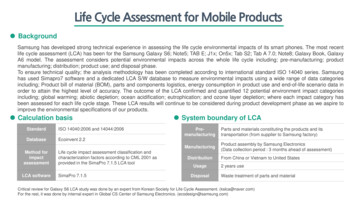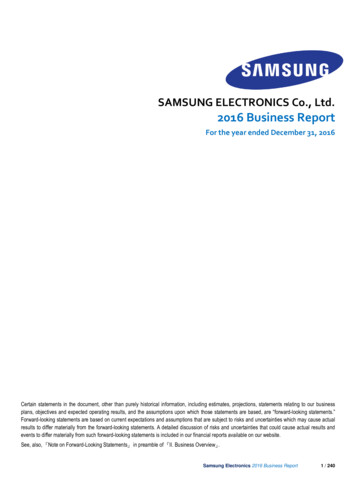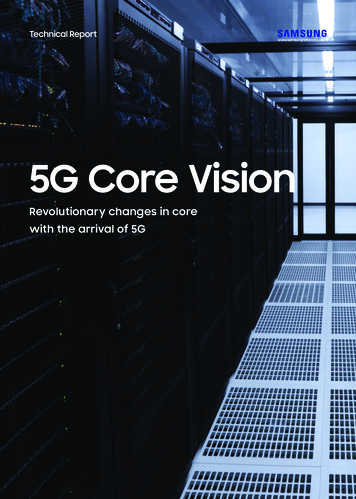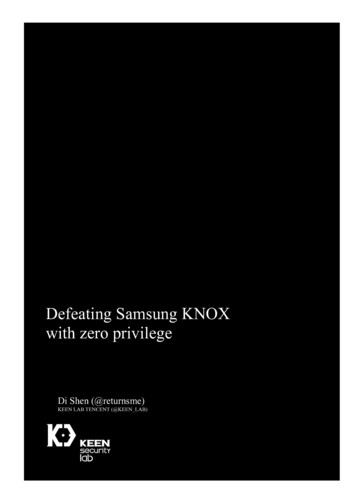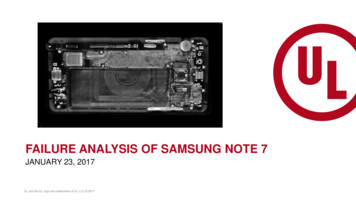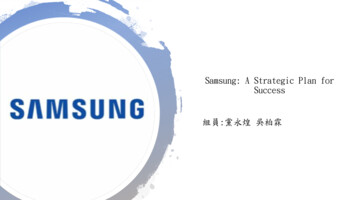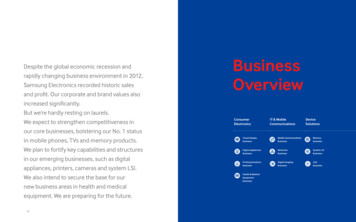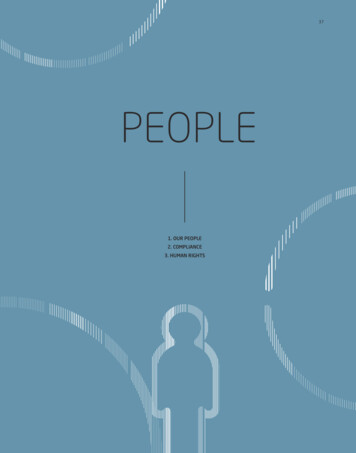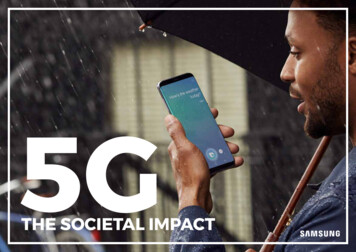
Transcription
5GTHE SOCIETAL IMPACT1
FOREWORDBy Menno Van Den Berg, President Samsung Electronics BeneluxOver time, technological innovation has brought us prosperityand joy. It has and will continueto open possibilities that seemedunthinkable a few years ago,such as being able to share everymoment instantly thanks tosmartphones and mobile internet. Now society is preparing forground-breaking technologies likeartificial intelligence (AI), virtualreality (VR) and the Internet ofThings (IoT).2Samsung’s future 5G technologies will mean way more than afast-mobile internet connection;they will propel the 4th industrialrevolution and elevate other digitalinnovations to a whole new level;self-driving cars for instance.5G technologieswill mean waymore than afast-mobile internet connection.Samsung already invests heavilyin 5G, which is already one of thestrongest growth-driving businessareas and – more importantly – willmassively improve citizens’ lives.Samsung has compiled a trendreport on 5G and its impact onBelgian society. Belgium is a wellconnected society with the 6thfastest 4G network in the world.As Europe’s capital, Brussels andby extension Belgium should- with the help of governmentincentives - lead the charge when itcomes to a smooth roll-out of 5G.The efficient introduction andimplementation of a supersonic5G network will un-tap incredible possibilities in four sectorsin particular: healthcare, transport, entertainment and smarterindustry. Thanks to 5G, the smartsociety is near.In this trend report, Samsungshows you how and why.
INDEX5G: boosting smart society’s four pillarsSociety’s lingering healthcare issuesTalkative transportNext level in entertainmentSmart(er) industry3
What is5G?4
What is5G stands for the 5th Generation in mobile t’s a ground-breaking 2020’stechnology with a bandwidthspeed up to 200 times fasterthan its predecessor 4G.1G2.4 Kbps2G64 Kbps3G2,000 Kbps4G100,000 Kbps5G20,000,000 Kbps5G?As a supersonic network, 5G willpropel 8K and VR livestreamingviewer experiences and catalyze IoTand Smart City solutions. 5G willalso allow an uninterrupted transfer of mobile data thanks to its verylow latency. Its connection densitymakes it possible for a giganticgroup of devices to enjoy highspeed connections at events such aslarge music festivals. 5G will facilitate high-speed mobility handoversas well: trains and cars will eventually communicate autonomously.The history of wireless cellulartechnology kicked off in the 1980’s,when 1G networks became theanalog telecommunication standardfor radio signals. Its successor 2Gconnected the 2G-radio networkto the existing telephone network.Whereas the voice during a call wasjust modulated to a higher frequencyin 1G, 2G enabled the birth of SMSand MMS.3G in the 2000’s was able to process and transfer more informationthan 2G. This fueled the rise ofsmartphones and opened the doorfor mobile internet access, videocalling and emailing.The data-focused 4G network camenext, providing a mobile broadbandinternet access that significantlysped up internet connections.Among other things it madestreaming platforms, gamingservices, high-definition mobileTV, video conferencing and cloudcomputing possible.5G is right around the corner andwill generate even more opportunities, especially in the fields ofhealthcare, transport, entertainment and the economy.Death of Wi-Fi?!Wi-Fi became popular at theend of the 90’s because it gavepeople the ability to connectdevices such as computersand later smartphones to theinternet within a particulararea, without messy wires.5G will possibly make Wi-Fias we know it redundant.That’s because connecteddevices will either have ane-sim through which they directly connect to the internet,or a central router will pickup a 5G signal and spreadit around the house makingfiber-based connectionsredundant.Once fiber-based connections top the speed of 5G,then we probably will use acombination of both, butuntil then 5G will prevail.5
5G:boosting smart society6
5G:boosting smart society’sFOUR PILLARSThe rise of digital technologies has been transforming nearly every aspect of modern life.Most people are online 24/7, have access to aseemingly endless amount of data and havemultiple devices – smartphone, home securitysystems and a refrigerator for instance –interconnected. This smart society allows usto focus our resources and capital on the activities and relationships that matter the most.The smarter our society becomes, the morepeople will benefit. Enter 5G: the indispensablecatalyst that brings society to the smartestpossible level by elevating four pillars; healthcare, transport, entertainment and industry.5G has the potential to impactglobal society as much as theinventions of the telephone, thetelevision and even the internet.This revolutionary technology will enablean Internet of Medical Things (IoMT) thatwill among other things help elderly to liveautonomously, introduce remote surgeries andleverage the breakthrough of wearable devicesthat will allow personal care and long-distancemonitoring. Considering transport, 5G will facilitate vehicle-to-vehicle communication anddriverless cars – leading to less traffic jams andsafer roads in general – and improve the functioning and popularity of public transport.5G will transform the entertainment sector. Itwill make tv experiences more personalizedand interactive than ever before, let gamersfeel the physical blows their virtual characterssuffer and bring personal assistants to life usingholograms. Finally, 5G’s speed and low latencyallows a drastic shift on an economic level, too.Both production and logistics will face considerably less bottleneck issues and enjoy smoothand safe electronic payments. E-commerceexperiences can continue their steep rise and anall-round virtual retail will enter the scene.Labelling 5G as simply the successor of 4Gin a series of mobile telecommunication generations would not do this invention justice.5G has the potential to impact global societyas much as the inventions of the telephone,the television and even the internet.HEALTHCARETRANSPORTENTERTAINMENTINDUSTRY7
HEALTHCARE8
SOCIETY’S LINGERINGHEALTHCARE ISSUESHealthcare technologies have mademassive leaps forward over the lastdecades, resulting in an overallhealth improvement. Gapminderstatistics show that Belgians born in2018 are expected to live on average8 years longer (81,2) than the generation that was born in 1980 (73,2).Lung cancer has become 25% lessdeadly for Belgian males in a timespan from 2002 to 2016: droppingfrom 80,5 deaths per 100,000 mento 60,8 two years ago. There’s a similar positive trend for breast cancer.Its mortality rate decreased 20%,from 30 deaths per 100,000 womenin 2002 to 24,1 fatalities in 2016.The introduction and implementation of 5G in healthcare can provideeffective and groundbreaking solutions from which all healthcare stakeholders – hospitals, doctors andmost importantly patients – wouldbenefit. 5G can tackle the threehottest topics in healthcare throughthe development of the Internet ofMedical Things (IoMT): the ageingpopulation, long-distance roboticsurgery, and an improved personalhealthcare via monitoring.Ageing societyposes a new challengeto Belgium9
1IoMT* helps the growing numberof elderly people live autonomouslyBelgium’s steadily ageing population puts the healthcare systemunder pressure. The numbers speak for themselves. In 2016, the ratioof people suited for the labor market – aged 18 to 66 – versus elderly,aged 67 or older, was already just four to one. By 2060, that ratio willbe two and a half to one as 39% of all Belgians will be 67 or older,according to the official Belgian government statistics bureau Statbel.This shift in demographics places added demands on healthcaresupport, as more and more people will need all-round medicalassistance and percentage-wise the working population will drop.The arrival of 5G allows for the creation of an IoMT. Seamlesslyconnected medical devices can meet those new needs by helpingseniors live more independently. Think of visible ones as watches79%199121%75%201625%61%206039%Ratio working people vs. retired peopleSource: statbel.fgov.beConnected medical devicesand an IoMT will assist seniorslive more autonomouslythat measure your heart rate, and implants like the next generationpacemaker.Connecting medical devices to homes will form one broad IoMT,autonomously monitoring the physical state of elderly patients.Monitoring elderly people’s health from afar by high-tech medicaldevices would also lower the number of hospital checkups theywould need, and reduce the number of medical visits by healthcareworkers. AI technology can help during emergency phone calls too,by processing data from wearable devices instantly.10*IoMT: The ‘Internet of Medical Things’, can be compared to the Internet of Things,but with focus on connected medical tools. This could lead to the next level in medical services. Ex: A smartwatch connected to the emergency services.
Thanks to 5G, surgeons will be able to performremote surgery - which means they won’t evenneed to be in the same operating theatre25G simplifies access tospecialists worldwide withremote surgeryStill too often, an unfortunate family makes headlines whenone of its children suffers from a rare, life-altering disease.As these illnesses can’t be cured by any easily available surgery, a super expensive treatment abroad is often the onlysolution. Besides the money and the specialists’ availability,the physical distance between the specialist’s operating roomand the Belgian patient is often a major issue.Thanks to 5G’s extremely fast connection and almost nonexistent latency, a surgeon in, for example the United Stateswill be able to perform robotic surgery using a high-definition livestream in Belgium without any lag or delay. Whilethis potentially life-saving technology is still at an early stage,Belgium already wants to take on a key role in overcomingphysical barriers to cutting edge healthcare worldwide. Itunderlined that ambition by opening Orsi, the world’s largestrobot surgery training center in Melle in September 2018.11
3Wearables enable personal careand long-distance monitoringIt’s better to be safe than sorry,especially considering Belgianpatients’ health. That’s whycontinual prognosis, rather thandiagnosis, should be the goal.Severe gradually developingconditions or sudden lifethreatening physical breakdownscall for constant proactivemonitoring, not just for the needsof patients but also for healthcarebudgeting.5G will enablehealthcareto focus onprognoses ratherthan diagnosesWearables connected through 5Gare the way to do this. A studyby Stanford University School ofMedicine concluded that wearables can predict when we willbecome ill. Monitoring on a largescale could, with the help of big12data - predict and thus limit thespread of epidemics. Data fromthe wearables would be transferred and processed at 5G speed.Patients support the move towearable health monitors. A PwCstudy revealed that 80% believethat wearables can make healthcare more convenient. Hospitalscould benefit as well and save16% of their budget, as CDWHealthcare, an IT resource thatmonitors over 15.000 healthcareorganizations, calculated. Thisthanks to a bunch of cloud-basedservices together with high-techmedical devices and improvedadministrative tools.The Belgian start-up FibriCheckis a prime example of howwearables can enable personalcare and enhance long distancemonitoring. It’s the first medicalcertified solution – in the formof an app – that detects cardiacarrythmia early. The app measures your heart rhythm when youpress your finger on your smartphone camera for 60 seconds.Doctors are already suggestingthe app and can easily monitorpatients from a distance andintervene depending on theoutcome of the test. It’s a groundbreaking preemptive approach.FibriCheck says irregular heartbeats are responsible for 20% ofall strokes and 75% of strokes canbe prevented by quick interventi-on and active follow-ups.Besides cardiac patients, diabeticscan benefit from 5G wearablesas well. The US based companyDexcom G6 manufactured aContinuous Glucose Monitoringsystem (GCM) that outshines thetraditional finger-stick tests.Those tests measure one pointin time and give no indicationwhether glucose levels are risingor falling. The GCS device allowspatients to track trends overtime, helping them to improvetheir insulin regime. Diabeticscan share their personal glucoseinformation with up to five peoplethrough the app.Hospitals couldbenefit as welland save 16% ontheir budgetThis offers peace of mind for aparent with a diabetic child andprovides doctors 24/7 bloodsugar level information on theirpatients. 5G will dramatically improve healthcare. IoMT will helpthe growing number of elderlypeople to live autonomously.5G’s speed and low latency willsimplify access to specialistsworldwide by erasing physicalborders.Wearables will enable personalcare and long-distance monitoring – fueling the shift fromreactive healthcare to preventivepersonal care. Samsung supportsthis technology-driven advance inhealthcare. Thanks to the intuitiveSamsung Health app for instance;through which people staywell-informed about their activity,nutrition and heart rate. Soon, wewill able to consult a doctor viathe Samsung Health app.
TALKATIVETRANSPORT13
TALKATIVEtransportDespite the rise in ride sharingsystems and excellent accessto an extensive public transportnetwork, Belgians still like tostay in their own driver’s seat.Numbers by the Belgian FederalGovernment Department ofMobility illustrate the steep riseof ‘vehicle kilometers’ or the totalamount of kilometers all vehiclescombined drove on Belgian roads:29 billion in 1970, 70 billion in1990, 90 billion in 2000 and 100billion in 2016.14Our roads and infrastructuresystems often get clogged up withtraffic. In 2014, nowhere in theworld did drivers lose so muchtime
reality (VR) and the Internet of Things (IoT). Samsung’s future 5G technolo-gies will mean way more than a fast-mobile internet connection; they will propel the 4th industrial revolution and elevate other digital innovations to a whole new level; self-driving cars for instance. Samsung already invests heavily in 5G, which is already one of the

